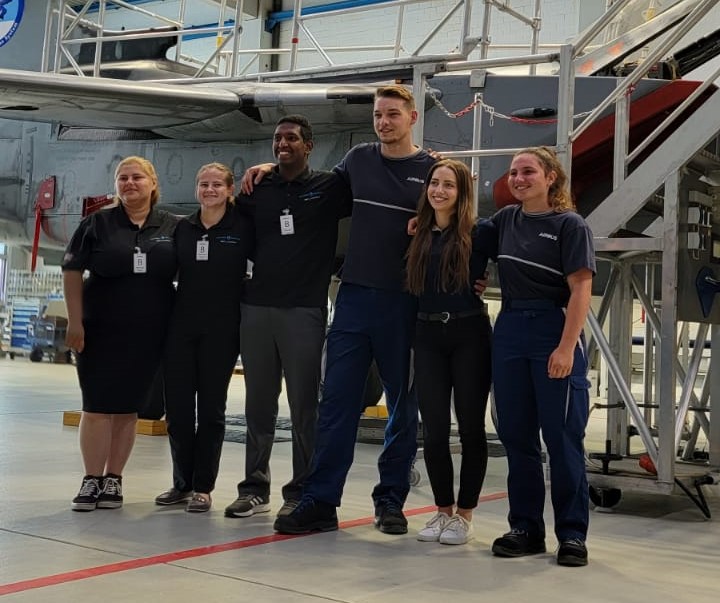September 27, 2022 – When deliberating an apprenticeship program versus college courses, Tarun Kumaravel saw his choice clearly: “If I do four years of college, that is four years of my time. Then I have to find work. Meanwhile, with an apprenticeship, it is two years, and you have both work and college at the same time.” Kumaravel is part of the Space Coast Consortium Apprenticeship Program (SCCAP), which is supported by IACMI at Eastern Florida State College, located in Cocoa, Florida. More and more students like Kumaravel are choosing an unconventional education to gain practical experience faster. With this combination of simultaneous classroom learning and hands-on work, participants can apply their knowledge to their career immediately.
Tying Education in Classroom with Industry
Focused on machining and composite materials, this apprenticeship provides more than just two years of work experience; students also receive a two-year degree upon completion. The apprentices spend two days in the classroom, three days in the workplace, and eight hours in the mechatronics lab weekly. The program partners with companies like Knight’s Armament Company, ITT Matrix Composites, and Airbus OneWeb Satellites, one of only two companies that can mass produce satellites and the workplace for three exceptional apprentices.

For Kumaravel who works in production engineering support, the connection of industry and educational experience is one of the most valuable parts of the program. “Being able to learn at the practical level helps me to understand at the university level,” he explained. “What we learn in our theoretical and lab classes, we apply in our workplace.” Kate Borrelli, a facilities maintenance technician apprentice, agreed that the combination of classwork and industry work was helpful for her training. “The labs that we had every week always tied in pretty well to what we were doing elsewhere,” she said.
Benefits of Apprenticeships
One perk of the apprenticeship program is that since participants are trained across multiple jobs, they develop a wide range of skills. Carolyn Macgowan, an apprentice in electrical ground support equipment, appreciates this aspect of the program since she’s been more intrigued by applicable science than the mathematical and theory sides. She said, “Through this program I learned that you can be doing hands-on work with space technology without being an engineer sitting behind a desk. It’s something I didn’t know was a possibility.” She went on to explain that through the broad training the program offers, she discovered that she had a passion for electrical work. To Macgowan, there is no doubt about how important her work is. She said, “My job is to jump in if something doesn’t go as planned to try and troubleshoot the issue. I am a key player in making sure the satellites are working and functioning properly.”
Borrelli also feels fulfilled by her work in the apprenticeship program. Maintaining facilities, her work is critical to efficiency in production. She explained, “I help maintain the building that the satellites are made in. We try to make sure that everything is working nominally so that they can keep production going.” Working with HVAC and machining equipment, Borrelli is grateful for a constant change of focus. “Having a job that changes from day to day is really nice because I have ADHD, so doing the same thing day in and day out can get a little boring. It’s nice to have that constant change of pace,” she said. Though the facilities maintenance team faces a variety of issues, each member has their specialty. Borrelli’s specialty is robotics. When an issue arises, she said, “My team lets me take the lead because I am the most knowledgeable in that area.” To Borrelli, figuring out a problem and knowing how to fix it is one of the best parts of the job.
Kumaravel shared that he thinks apprenticeship programs should be more common because they help create skilled workforce individuals. He is grateful for the daily opportunities to brainstorm and face challenges in the aerospace industry. When asked about his overall experience with the apprenticeship, Kumaravel only had positive things to say: “I’m glad I made this decision. I have three years of work experience, I am 20 years old, I’m making decent money, and I’m having a good life.”
Reenvisioning Manufacturing
All the apprentices agreed that the world needs to change the way it views manufacturing jobs and non-traditional paths. Kumaravel said, “People need to get out of thinking that manufacturing is a dirty job. In my department, it is very clean with little moisture content in the air.” Macgowan explained that everything that goes into space must be clean, so the satellites are manufactured in a “clean room.” This standard of cleanliness would not be possible without Borrelli. “I keep our clean room in specifications, and I keep the particles down. Also, there is so much more to this field. There are engineers, office workers, maintenance technicians, and so many other positions,” Borrelli said. None of the apprentices have taken a traditional college path into the workforce, and it has worked well for them. Macgowan said, “I think it is important for students to look at methods other than the four-year university to start a career path.”

It’s clear the apprentices at Airbus OneWeb Satellites are happy with their experience. When asked what they would say to their younger selves when considering the program, they all had encouraging answers. “Always be open to new opportunities. Don’t be afraid of a startup program,” Macgowan said. Borrelli answered, “This is a good career path to go into and grow in. You can never go wrong with a job where you have to maintain some kind of equipment. You have job security.” Kumaravel said, “You can step into the workforce easier. It is inspiring for me to talk about my experience.”
About IACMI’s Support
IACMI and collaborators are establishing a national Advanced Composites Career Pathways (ACCP) learning network to develop a skilled advanced composites manufacturing workforce. It is based on the best-in-class program at Davis Technology College in Utah and adapted to the needs of regional ecosystems. Similar learning centers are underway in Alabama at Enterprise State Community College in Enterprise and in New York at the Composites Prototyping Center in Long Island. Led by IACMI, this national workforce initiative is part of the U.S. Department of Defense (DoD) Office of Naval Research’s Manufacturing Engineering Education Program (MEEP). MEEP programs prepare current and next-generation manufacturing workers to produce military systems and components that assure defense technological leadership.
Editors Note: The Airbus OneWeb Satellite apprentices have recently won first-place at the first-ever international mechatronics competition at IMTS Student Summit in Chicago.
